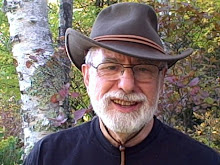My last, and most severe, bout with this condition occurred in 1991 when I was taken from my home, immobilized, on a back board to an emergency room. After spending the next week in the hospital flat on my back, a neurosurgeon suggested that I might want to consider back surgery to alleviate this chronic condition.
Having witnessed the many negative results of this kind of intervention with many other back pain patients, I was strongly opposed to it in spite of my chronic misery.
Shortly thereafter, I first learned of Mindfulness-Based Stress Reduction (MBSR), a revolutionary new means of coping with chronic pain developed by Dr. Jon Kabat-Zinn at the University of Massachusetts Medical Center in Worcester, MA. Since I had been personally practicing mindfulness meditation since 1975, I immediately became very interested and started learning more about it.
This led to my participation in a week-long training course with Dr. Kabat-Zinn in 1993. I then developed a similar program at a large hospital in Mpls, MN--the first of its kind in Minnesota.
From then until I retired in 1999, I gained great satisfaction by being able to share this highly effective approach with several hundred people, nearly all of whom were dealing with overwhelmingly challenging illnesses entailing physical and/or psychological pain.
At the end of this intense 8-week course, a high percentage of these patients reported that they were coping much more effectively with pain as a result of the training they received.
One part of this program entails gentle, mindful stretching. To my surprise and delight, as a result of consistently leading others in learning this process, I personally experienced a gradually-increasing degree of low back pain relief myself. I'm even more happy to report that my low back pain continued to diminish progressively and that it has now been completely absent for several years.
I really wasn't expecting this result, because the main objective of MBSR is to provide a means of coping effectively with all forms of chronic pain--not to get rid of it as such. Through the consistent practice of mindfulness, however, it's not uncommon for such pain to become subjectively less intense as one learns how to "relax into it" mindfully, instead of reacting to it automatically.
So what is mindfulness? Most basically, it consists in simply paying careful, moment-to-moment attention to all internal and external experience while simultaneously accepting it and allowing it to be just as it is, without judging or trying to change it in any way whatever. It is, in other words, a means of living fully, consciously, and non-reactively in the present moment, instead of reacting negatively, or getting attached, to current experience and/or getting lost in thoughts about the past or the future.
This tendency to get "lost in thought" is strongly habitual for most people. At the very least, it tends to deprive us of "capturing our moments"--i.e., of living fully in the present. Even worse, however, since much of our thinking is negative, it's a major root cause of what we commonly call "stress."
Chronic pain, as is true of all unpleasant life experiences, is inevitably worsened as we react to it automatically. This contributes to the well-known "splinting reaction," whereby the more one's muscles tighten automatically in an attempt to control the pain, the greater the pain tends to become. By focusing moment-to-moment on the pain without judging or trying to make it go away, the vicious cycle of the splinting reaction tends to diminish. One common effect of this is a reduction in the level of subjective pain.
Even more importantly, however, mindfulness is very empowering to anyone with chronic pain, because it provides an effective means of "making friends with it," so to speak, and of living a much fuller, more satisfying life as a result.
So I strongly encourage anyone seeking low pack pain relief to consider this highly effective strategy very carefully. I intend to devote this blog to providing ongoing support to those who want to learn and utilize it.

